Method of treating a liquid including an organofluorine
a technology of organofluorine and liquid treatment, which is applied in the nature of water treatment, multi-stage water/sewage treatment, treatment involving filtration, etc., can solve the problems of difficult degradation of such alkylfluorine, difficult separation of foams from liquids including water, and biological persistence and refractory nature of foams, etc. problems, to achieve the effect of significant and harmful effects on food chains
- Summary
- Abstract
- Description
- Claims
- Application Information
AI Technical Summary
Benefits of technology
Problems solved by technology
Method used
Image
Examples
example 1
[0241]The ammonia depleted leachate was subjected to electrochemical treatment using the apparatus of FIGS. 7-17, which has 13 electrode plates to provide 12 active cells. The electrochemical treatment was performed with a cell residence time of 45 seconds, a flow rate of 0.7 litres per minute, using mild carbon steel electrodes. The distance between electrodes was 3 mm, and the voltage applied was 1.1 volts per cell (one cell is the space between two adjoining electrodes). Electrode polarity was reversed every 30 seconds to avoid cathode passivation. The temperature of the liquid being treated was near ambient temperature (around 25-30° C.). No gases or other treatment agents were used during the electrochemical treatment.
[0242]Foam was produced during the electrochemical treatment. Without wishing to be bound by theory, it is believed that foam production was enhanced by the production of hydrogen gas at the sacrificial electrodes during the electrochemical treatment. After produc...
example 2
[0245]The ammonia depleted leachate was subjected to electrochemical treatment using the apparatus of FIGS. 18-22, which has 160 electrode plates. The electrochemical treatment was performed with a cell residence time of 45 seconds, a flow rate of 11.09 kL per hour (3.08 L per second), using mild carbon steel electrodes. The distance between electrodes was 3 mm, and the voltage applied was 1.1 volts per cell (one cell is the space between two adjoining electrodes). The target current was 9 amps. Electrode polarity was controlled externally to avoid cathode passivation. The temperature of the liquid being treated was near ambient temperature (around 30-32° C.). No gases or other treatment agents were used during the electrochemical treatment.
[0246]Foam was produced during the electrochemical treatment. Without wishing to be bound by theory, it is believed that foam production was enhanced by the production of hydrogen gas at the sacrificial electrodes during the electrochemical treat...
PUM
| Property | Measurement | Unit |
|---|---|---|
| current densities | aaaaa | aaaaa |
| pressure | aaaaa | aaaaa |
| dipole moment | aaaaa | aaaaa |
Abstract
Description
Claims
Application Information
 Login to View More
Login to View More - R&D
- Intellectual Property
- Life Sciences
- Materials
- Tech Scout
- Unparalleled Data Quality
- Higher Quality Content
- 60% Fewer Hallucinations
Browse by: Latest US Patents, China's latest patents, Technical Efficacy Thesaurus, Application Domain, Technology Topic, Popular Technical Reports.
© 2025 PatSnap. All rights reserved.Legal|Privacy policy|Modern Slavery Act Transparency Statement|Sitemap|About US| Contact US: help@patsnap.com



